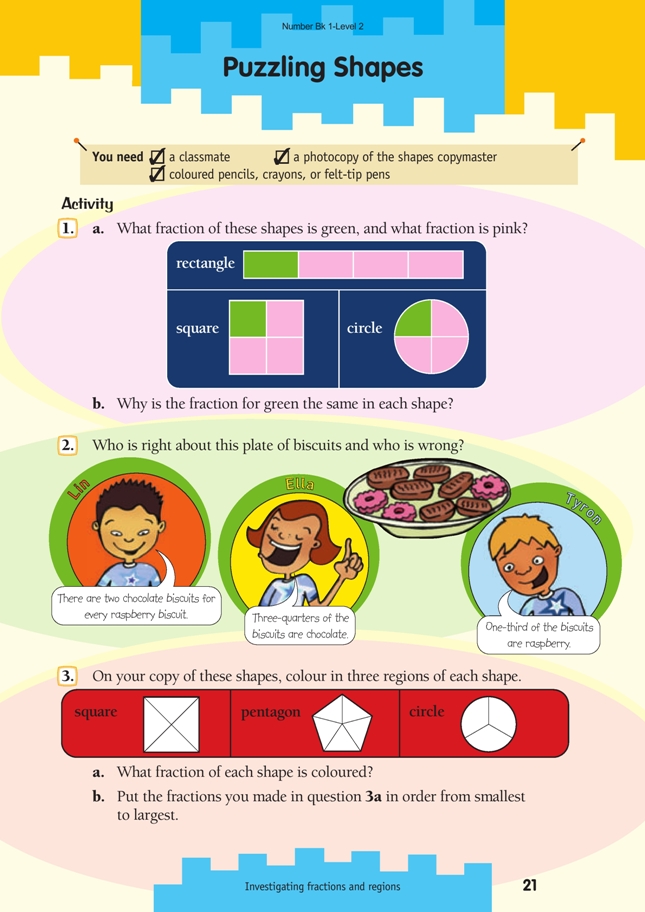This is a level 2 number activity from the Figure It Out series. It relates to Stage 5 of the Number Framework.
A PDF of the student activity is included.
Click on the image to enlarge it. Click again to close. Download PDF (164 KB)
find a fraction of a region
find a fraction of a set
FIO, Level 2, Number, Book 1, Puzzling Shapes, page 21
Coloured pencils, crayons, or felt tip pens
Classmate
In this activity, the students are dealing with fractions of regions (questions 1 and 3) and fractions of sets (question 2). When doing question 1, the students need to see that the same fraction (onequarter) can be different sizes and shapes. This shows why it is important to always relate a fraction to the whole, for example, “one-quarter” can have many meanings, so it’s important to specify the context, for example, “one-quarter of the cake”, “one-quarter of 16”, and “one-quarter of the square”.
Your students may find it helpful to use counters (one colour for raspberry and a different colour for chocolate) to solve question 2.
The copymaster of the Fraction Memory cards at the back of this book has a set of cards with different expressions for fractions. You could also use these cards for this activity, with the addition of the cards below.
The words “share equally between two” relate to dividing a set of objects in half, whereas “1 divided into two equal parts” relates to an area model of one-half.
It’s important that the students develop confidence in using the varied language of fractions, along with an understanding that there are several ways to talk about the same fraction. Use the students’ ideas as a starting point. Present them with the symbolic recording for one-quarter (1/4) and invite them to talk about what they think the 4 means. “What about the 1?” This does, of course, need to be introduced alongside a concrete model of one-quarter.
In question 3, the students are asked to label the fractions they have coloured on each of the shapes. If they can express the shaded area of the square as “three out of four equal parts”, then recording 3/4 is likely to be straightforward. The students may need prompting with questions such as “How many equal parts has the square been cut into?” “What’s the name for that fraction?” “How many quarters have you coloured in?”
The students are then asked to put these fractions in order. Although ordering fractions with different denominators might seem advanced for students at level 2, they are asked to do this with the visual support of the fractions they have themselves created. Because all the numerators are 3, you could use this question to explore the relationship between the size of a fraction and the denominator, that is, that the greater the denominator, the smaller the fraction (where the numerator is constant). Although you may not expect the students to use the terms numerator and
denominator, it is appropriate for you to introduce these words while working with fractions.
Answers to Activity
1. a. 1/4 green and 3/4 pink for each shape
b. Each shape is divided into four equal parts, and one of those parts is coloured green.
2. Lin and Tyron are right, and Ella is wrong.
3. a square: 3/4
pentagon: 3/5
circle: 3/3 or 1 (whole)
b. 3/5, 3/4, 3/3

